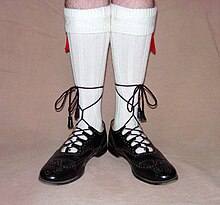Brogue
Brogue (of Gäl-schott.. Brog , ir. Brog "shoe") is the generic term for a particular group of shoe models , extending through hole ornaments shaft distinguished (shaft portion and toe edges).
Historical
Brogues go back to shepherds in Scotland and Ireland who drilled holes in their shoes in order to be able to drain the water that had entered their shoes on the marshy ground. The openings also aided faster drying.
The practice later became generally socially acceptable through the hunters of the Scottish nobility. In the 18th century, the brogue had already proven itself as the standard shoe of the working country population in Great Britain. Still today there are the so-called ghillie brogues or ghillies , named after the Scottish game rangers . This variant, which works without a tongue and is laced at the ankle , is preferred to wear with a kilt .
The three common variants of the Brogue ( Half- or Semibrogue , Fullbrogue , longwing ) came early 20th century for the first time in fashion.
variants
Today's brogues are no longer provided with through holes. Instead, the additional outer shaft parts are decorated with holes ( broguing ). One differentiates the group of brogues in
Half or semibrogue
In these shoe models, only the toe cap (so-called cross - cap ), which is additionally attached to the shaft from the outside, is decorated with an ornamental perforated line, the so-called rosette and the edge of the toe cap are often provided with lyre perforations . Otherwise this model is very reserved with decorations; Other parts of the shaft are rarely decorated (perforation or serration). Half brogues are mostly made of smooth calfskin. Often they are made with the open Derby or with the closed Oxford lacing.
Full brogue
Instead of a straight toe cap (cross cap), this shoe model has a so-called wing cap (see illustration) that extends down to the side of the shaft. Both the edges of the wing cap and the other shaft part edges are provided with a lyre perforation and / or are jagged . The Lyra perforation is a punching technique follow in two superimposed detached small holes on a larger hole. This pattern usually only varies in the size of the hole, less often in the shape of the hole. Centrally on the top of the wing cap, above the toe of the shoe, a rosette is attached as a hole decoration. A heel cap is also typical of full brogues. Full brogues are often made with embossed Scotchgrain upper leather.
Longwing
The Longwing has a wing cap, the side extensions (the wings) of which extend back to the heel seam. That's why it doesn't have an additional heel cap. Otherwise, the characteristics of the full brogues developed in the USA apply. It usually has an open lacing and then looks more sporty and is primarily a suitable companion for casual clothing.
Half and full brogues are available with both open lacing (Derby type) or closed lacing (Oxford type); the Longwing is mostly built with open lacing (Blüchertyp).
use
Shoes with hole decorations ( broguings ) are mostly men's shoes. The half brogue can still be combined with a business suit. The full brogue , on the other hand, is more considered a sporty shoe and is therefore more likely to be worn with sporty combinations or (especially in brown color and coarser or rough upper leathers) with casual clothing. The sporty appearance is particularly pronounced in the Longwing , which is why it is not combined with business clothing, but reserved for casual clothing.
Difference to the Budapest
In common parlance, full brogues with a Derby cut are sometimes referred to as Budapest . But the brogue is slimmer and has, in addition to other visual distinguishing features compared to the Budapest shoe model, a normally rounded, sloping toe.
literature
- Helge Sternke: Everything about men's shoes . Nicolai, Berlin 2006, ISBN 3-89479-252-3 .



